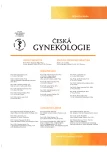Importance of addition of HPV DNA testing to the cytology based cervical cancer screening and triage of findings with p16/Ki67 immunocytochemistry staining in 35 and 45 years old women
LIBUSE trial data analysis
Authors:
J. Sláma 1; V. Dvořák 2; M. Trnková 3; A. Skřivánek 4; K. Hurdálková 5; P. Ovesná 5; Marta Nováčková 5
Authors‘ workplace:
Gynekologicko‑porodnická klinika VFN a 1. LF UK, Praha, přednosta prof. MUDr. A. Martan, DrSc.
1; Centrum ambulantní gynekologie a primární péče, s. r. o., Brno, vedoucí lékař MUDr. V. Dvořák, Ph. D.
2; AeskuLab Patologie, k. s., Praha, vedoucí lékařka MUDr. M. Trnková
3; G‑Centrum, s. r. o., Olomouc, vedoucí lékař MUDr. A. Skřivánek, Ph. D.
4; Institut biostatistiky a analýz, s. r. o., Brno, jednatel Ing. P. Brabec, Ph. D.
5
Published in:
Ceska Gynekol 2020; 85(6): 368-374
Category:
Overview
Objective: The study evaluates results of 2-years follow-up of patients in ages 35–36 and 45–46, who are participating in the project LIBUSE, that deals with efficacy of HPV DNA and Pap smear co-testing and p16/Ki67 dual staining in the Czech national cervical screening.
Design: Prospective observational study.
Setting: Department of Obstetrics and Gynecology, General University Hospital and 1st Medical Faculty, Charles University, Prague.
Materials and methods: Out of all women enrolled in the project LIBUSE only those who were at the beginning of the study 35–36 and 45–46 years old were sellected. Conventional Pap smear and HPV DNA test (Cobas 4800, Roche Diagnostics) had been collected at the baseline. Women were stratified according to their results in the three risk groups: 1. low-risk, 2. high-risk and 3. intermediate risk, who subsequently underwent p16/Ki67 dual staining. All high-risk patients and those with positive result of dual staing were refered to the expert colposcopy. The cases with biopsy proven precancers or cancers were considered as „positive findings“.
Results: Altogether 352 women meet the age requirements. In 26 (7.6%) women had been proven HPV DNA positivity and out of the them 9 cases were HPV 16/18 positive. Severe cytological abnormality was found only in one patient (0.3%), who was simultaneously HPV positive. Ten women (2.8%) were classified as high-risk and directly refered to colposcopy. Another 18 patients underwent p16/Ki67 dual staining and 4 positive cases were refered to colposcopy too. After one year further 9 patients were classified as intermediate risk and 6 more were identified after two years of follow-up. Within two years 9 more patient were refered to colposcopy. After the entire period of follow-up in 10 patients biopsy confirmed precancer lesions, none of them had invasive cancer.
Conclusions: Addition of HPV DNA testing with selective HPV 16/18 genotyping to the cytology based screening significantly increases sensitivity and safety of our cervical screening program
Keywords:
HPV test – cervical cancer – precancer lesion – p16/Ki67 – screening
Sources
1. Khan, MJ., Castle, PE., Lorincz, AT., et al. The elevated 10-years risk of cervical precancer and cancer in women with human papillomavirus (HPV) type 16 or 18 and the possible utility of type-specific HPV testing in clinical practice. J Natl Cancer Inst, 2005, 20, 97(14), p. 1072–1079.
2. Kjaer, SK., Frederiksen, K., Munk, C., Iftner, T. Long-term absolute risk of cervical intraepithelial neoplasia grade 3 or worse following human papillomavirus infection: role of persistence. J Natl Cancer Inst, 2010, 102, p. 1478–1488.
3. Májek, O., Dušek, L., Dvořák, V. Výsledky screeningu karcinomu hrdla děložního v ČR. Ústní sdělení, 12. konference Sekce kolposkopie a cervikální patologie ČGPS ČLS JEP, Orea Hotel Pyramida, Praha, 29. 11.–1. 12. 2019.
4. McMenamin, M., McKenna, M., McDowell, A. Clinical utility of CINtec PLUS Triage in Equivocal Cervical Cytology and Human Papillomavirus Primary Screening. Am J Clin Pathol, 2018, 24, 150(6), p. 512–521.
5. Meijer, CJ., Berkhof, J., Castle, PE., et al. Guidelines for human papillomavirus DNA test requirements for primary cervical cancer screening in women 30 years and older. Int J Cancer, 2009, 124, p. 516–520.
6. Petry, KU., Schmidt, D., Scherbring, S., et al. Triaging Pap cytology negative, HPV positive cervical cancer screening results with p16/Ki-67 Dual-stained cytology. Gynecol Oncol, 2011, 1, 121(3), p. 505–509.
7. Rijkaart, DC., Berkhof, J., Rozendaal, L., et al. Human papillomavirus testing for the detection of high-grade cervical intraepithelial neoplasia and cancer: final results of the POBASCAM randomised controlled trial. Lancet Oncol, 2012, 13(1), p. 78–88.
8. Ronco, G., Dillner, J., Elfström, KM., et al. International HPV screening working group. Efficacy of HPV-based screening for prevention of invasive cervical cancer: follow-up of four European randomised controlled trials. Lancet, 2014, 8, 383(9916), p. 524–532.
9. Sehnal, B., Sláma, J. Jak dále ve screeningu karcinomu děložního hrdla? Čes Gynek, 2020, 85(4), s. 236–243.
10. Sheikh, S., Biundo, E., Courcier, S., et al. A report on the status of vaccination in Europe. Vaccine, 2018, 9, 36(33), p. 4979–4992.
11. Whitlock, EP., Vesco, KK., Eder, M., et al. Liquid-based cytology and human papillomavirus testing to screen for cervical cancer: a systematic review for the U.S. Preventive Services Task Force. Ann Intern Med, 2011, 15, 155(10), p. 687–697.
12. Wright, TC. Jr, Behrens, CM., Ranger-Moore, J., et al. Triaging HPV-positive women with p16/Ki-67 dual-stained cytology: Results from a sub-study nested into the ATHENA trial. Gynecol Oncol, 2017, 144(1), p. 51–56.
13. Wright, TC., Stoler, MH., Behrens, CM., et al. Primary cervical cancer screening with human papillomavirus: end of study re-sults from the ATHENA study using HPV as the first-line screening test. Gynecol Oncol, 2015, 136(2), p. 189–197.
14. www.svod.cz
Labels
Paediatric gynaecology Gynaecology and obstetrics Reproduction medicineArticle was published in
Czech Gynaecology

2020 Issue 6
Most read in this issue
- Idiopathic polyhydramnios
- Total laparoscopic hysterectomy – clinical comparison of the method using two types of uterine manipulators
- Dienogest in the treatment of endometriosis
-
Importance of addition of HPV DNA testing to the cytology based cervical cancer screening and triage of findings with p16/Ki67 immunocytochemistry staining in 35 and 45 years old women
LIBUSE trial data analysis
